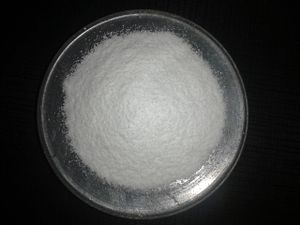Potassium peroxymonosulfate
 Store grade Oxone on a watch glass.
| |
| Names | |
|---|---|
| IUPAC name
Potassium peroxymonosulfate
| |
| Other names
Potassium monopersulfate
Oxone Caroat MPS | |
| Properties | |
| KHSO5 2KHSO5·KHSO4·K2SO4 (Oxone) | |
| Molar mass | 152.2 g/mol (614.76 as triple salt) |
| Appearance | White |
| Density | 2.17 g/cm3 |
| Decomposes | |
| Hazards | |
| Safety data sheet | ScienceLab |
| Related compounds | |
| Related compounds
|
Potassium persulfate Potassium pyrosulfate |
| Except where otherwise noted, data are given for materials in their standard state (at 25 °C [77 °F], 100 kPa). | |
| Infobox references | |
Potassium peroxymonosulfate, also known potassium monopersulfate or MPS, is the potassium acid salt of peroxymonosulfuric acid, with the chemical formula KHSO5. It is sold under the trade names Caroat and Oxone, where it exists as a mixture consisting of of 2KHSO5·KHSO4·K2SO4, as pure potassium peroxymonosulfate is unstable and breaks down in the latter two.
Contents
Properties
Chemical
Potassium peroxymonosulfate is a strong oxidizer, capable of oxidizing organic substances into various compounds, such as: aldehydes to carboxylic acids, alcoholic solvents to their coresponding esters, cleaving internal alkenes to two carboxylic acids and terminal alkenes to epoxides, ketones to dioxiranes, thioethers to sulfones, tertiary amines to amine oxides and phosphines to phosphine oxides.
Physical
Oxone is a white granular solid, with a weak bleach-like smell, that decomposes in the presence of water.
Availability
Potassium peroxymonosulfate is sold under the name of Oxone in most swimming pool stores and various home-improvement and gardening retailer stores.
Preparation
Potassium peroxymonosulfate can be prepared by reacting a concentrated solution of Caro's acid with a potassium salt, such as potassium carbonate. Potassium hydroxide can also be used.[1]
It can also be obtained via electrolysis of potassium persulfate in sulfuric acid. Potassium sulfate appears as a byproduct.[2]
Adding hydrogen peroxide to potassium persulfate also yields potassium peroxymonosulfate.[3]
Another method involves the hydrolysis of sodium persulfate at 100 °C to yield peroxydisulfuric acid. Solid potassium bisulfite is added, and the solution is filtered to remove the resulting potassium sulfate. The filtrate is freeze-dried and then washed with distilled water and filtered again at room temperature. The resulting filtrate is chilled on an ice bath, and the product is recrystallized for better purity.[4]
Projects
- Oxidize organic compounds
- Make dimethyldioxirane
Handling
Safety
Potassium peroxymonosulfate is a strong oxidizer and should be kept away from any reducing agents or organic compounds.
Storage
Oxone should be kept in closed plastic or glass containers, away from any combustible materials.
Disposal
Can be neutralized with water and an alkali and poured down the drain.
References
- ↑ http://www.google.com/patents/US4610865
- ↑ "Thomas Slater Price, J. Chem. Soc., Trans., 1906, vol 89, p 56".
- ↑ Klemenc, A.; Zeitschrift fuer Physikalische Chemie, Abteilung A: Chemische Thermodynamik, Kinetik, Elektrochemie, Eigenschaftslehre; vol. 185; (1939); p. 1 - 36
- ↑ "Price, J. S.; Tasker, I. R.; Appelman, E. H.; O'Hare, P. A. G.; Journal of Chemical Thermodynamics; vol. 18; nb. 10; (1986); p. 923 - 930".